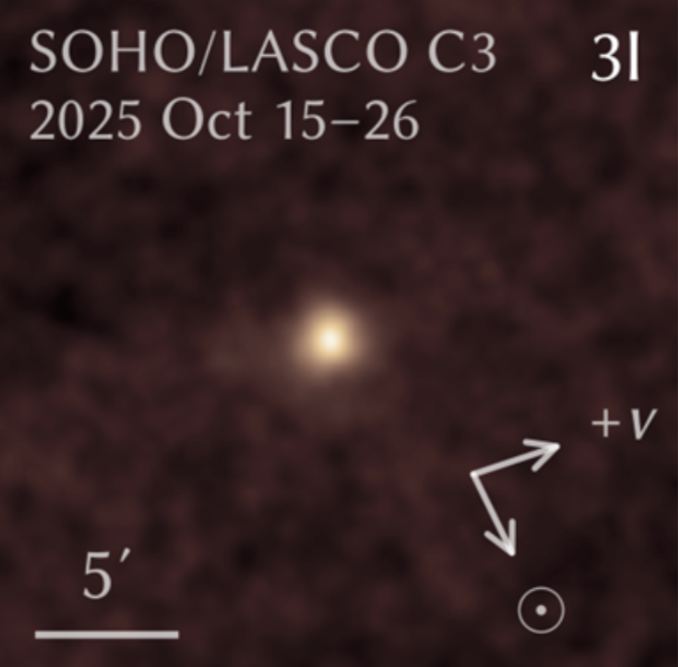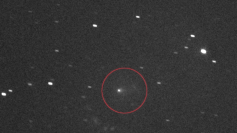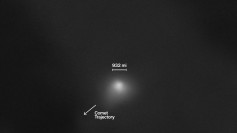When a faint green smudge appeared in images from a backyard telescope in Aguadilla, Puerto Rico, on Nov. 22, 2025, astronomers did not expect it to upend basic assumptions about how comets work. Yet the object, cataloged as 3I/ATLAS, is now forcing scientists to reconsider long-held models of comet structure, outgassing and even the dynamics of interstellar visitors entering the solar system.
3I/ATLAS is only the third confirmed interstellar object ever observed in our neighborhood, after 1I/ʻOumuamua in 2017 and 2I/Borisov in 2019. Discovered by the NASA-funded ATLAS survey telescope in Chile on July 1, 2025, it swung past the Sun at 1.36 astronomical units on Oct. 29 and has since behaved in ways that do not fit the playbook for icy bodies heated by solar radiation.
The most striking evidence came from amateur astronomer Efraín Morales Rivera, who used a 305mm telescope to image what initially looked like a featureless green comet with no visible tail. After digital enhancement, the data revealed something far stranger: a compact, bright core, flanked by bilateral gas emissions, and a sharp, forward-pointing anti-tail aimed toward the Sun instead of the broad, sweeping dust tail that typically trails behind a comet after perihelion.
Those features, documented by Rivera and echoed in professional observations, are now under intense scrutiny. At the core, gas jets appear to emerge asymmetrically from a tight central nucleus rather than from a diffuse coma. The enhanced images suggest directional vents or localized active regions rather than the more uniform sublimation expected from a sun-lit, rotating body. The green glow points to diatomic carbon molecules created as organic material breaks down under solar radiation, while hints of blue are consistent with ionized carbon monoxide and other molecular ions.
The anti-tail may be the most controversial element. The Hubble Space Telescope first recorded a sunward-facing structure in July 2025, months before perihelion. Harvard astronomer Avi Loeb has argued that such a feature "could theoretically function as a protective shield, clearing debris from the flight path through mechanisms analogous to electromagnetic deflection systems." For now, most dynamicists still treat the phenomenon as an exotic form of dust and gas alignment along the line of sight, but its persistence and sharp geometry keep the debate alive.
Equally puzzling is what the comet does not show. Based on non-gravitational acceleration data from NASA's Jet Propulsion Laboratory, 3I/ATLAS appears to have lost more than 13% of its mass near perihelion. Standard models say that much mass loss should produce a vast dust tail stretching hundreds of thousands of kilometers away from the Sun, as grains are pushed outward by radiation pressure and the solar wind. Rivera's Nov. 22 images instead depict a compact core and anti-tail, with no broad, diffuse dust plume of the kind familiar from Halley-type comets or even 2I/Borisov.
The modest but measurable non-gravitational acceleration-on the order of 5 × 10⁻⁷ astronomical units per day squared-would normally be interpreted as recoil from vigorous outgassing. Yet the morphology of 3I/ATLAS does not match the typical picture of icy jets steadily shedding material. Between Nov. 8 and Nov. 19, images from other observatories showed multiple thin jets, some stretching an estimated 2.85 million kilometers, but these were narrow and collimated rather than broad, fan-like dust structures. Their geometry suggests highly directional sources or mechanisms that cometary scientists have not yet fully described.
Spectroscopy has only deepened the mystery. Data from the James Webb Space Telescope in late August detected a nickel-to-cyanide ratio orders of magnitude higher than any known natural comet, along with a color evolution near perihelion that favored blue tones inconsistent with simple reflected sunlight. Researchers have proposed that unusually high concentrations of molecular ions such as CO⁺ and H₂O⁺ could explain the shift, but the composition does not sit comfortably within the standard taxonomy of cometary ices and dust.
Trajectory analysis has raised additional questions. Planetary-defense officials emphasize that 3I/ATLAS "poses zero collision threat to Earth," with its closest approach on Dec. 19, 2025, at roughly 1.8 astronomical units, or about 270 million kilometers. Yet the path it is taking through the solar system is unusually "tidy" for an interstellar object. Despite its retrograde orbit, its inclination lies only about 5 degrees off the ecliptic, a configuration that statistical models say should be rare for random entrants from interstellar space.
The geometry of upcoming encounters has also caught attention. After passing within roughly 97 million kilometers of Venus on Nov. 3, the object is now on track for a close approach to Jupiter on March 16, 2026, at an estimated distance of 53.445 ± 0.06 million kilometers. That is within Jupiter's Hill sphere-the region in which the planet's gravity can dominate over the Sun's for small bodies. Some orbital dynamicists note that the odds of an interstellar object arriving on a retrograde path aligned so closely with the ecliptic and then skimming the edge of Jupiter's gravitational sphere by chance are extremely low when both orientation and timing are considered.
These anomalies have led to speculative papers and online debate about whether 3I/ATLAS might be influenced by non-natural forces, echoing discussions that followed 1I/ʻOumuamua's non-gravitational acceleration in 2017. The mainstream view remains that unknown but natural processes-perhaps involving exotic ice mixtures, unusual internal structure or new forms of jet collimation-could explain the data. Even so, Loeb and his colleague Eric Keto have argued that future measurements of the anti-tail will be crucial. In their joint analysis, they write that "if upcoming observations confirm outflow velocities exceeding several kilometres per second, alternative explanations including technological origins would require serious consideration".




